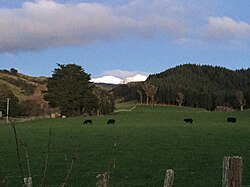Makahika
Makahika | |
|---|---|
Rural locality | |
 Looking east across Makahika to the Tararua Range | |
 | |
| Coordinates: 40°38′13″S 175°23′56″E / 40.637°S 175.399°E | |
| Country | New Zealand |
| Region | Manawatū-Whanganui region |
| Territorial authority | Horowhenua District |
| Wards |
|
| Electorates | |
| Government | |
| • Territorial Authority | Horowhenua District Council |
| • Regional council | Horizons Regional Council |
| • Horowhenua Mayor | Bernie Wanden |
| • Ōtaki MP | Tim Costley |
| • Te Tai Hauāuru MP | Debbie Ngarewa-Packer |
| Area | |
| • Total | 170.32 km2 (65.76 sq mi) |
| Population (June 2024)[2] | |
| • Total | 1,080 |
| • Density | 6.3/km2 (16/sq mi) |
Makahika is a rural locality in the Horowhenua District of the Manawatū-Whanganui region of New Zealand's North Island. It is located in the Makahika Stream valley. The stream runs southwest from the Tararua Range to join the Ōhau River.[3]
The Mangahao Makahika Track is a 15 km tramping track through the Tararua Range which takes 6-8 hours one-way depending on direction.[4]
Glamping accommodation is available at Arete Village, part of the Makahika Outdoor Pursuits Centre.[5]
Demographics
[edit]Makahika statistical area covers 170.32 km2 (65.76 sq mi).[1] It had an estimated population of 1,080 as of June 2024, with a population density of 6.3 people per km2.
| Year | Pop. | ±% p.a. |
|---|---|---|
| 2006 | 807 | — |
| 2013 | 858 | +0.88% |
| 2018 | 960 | +2.27% |
| Source: [6] | ||
Makahika had a population of 960 at the 2018 New Zealand census, an increase of 102 people (11.9%) since the 2013 census, and an increase of 153 people (19.0%) since the 2006 census. There were 372 households, comprising 504 males and 456 females, giving a sex ratio of 1.11 males per female. The median age was 50.6 years (compared with 37.4 years nationally), with 138 people (14.4%) aged under 15 years, 138 (14.4%) aged 15 to 29, 495 (51.6%) aged 30 to 64, and 189 (19.7%) aged 65 or older.
Ethnicities were 91.9% European/Pākehā, 11.9% Māori, 2.5% Pasifika, 2.5% Asian, and 1.9% other ethnicities. People may identify with more than one ethnicity.
The percentage of people born overseas was 16.2, compared with 27.1% nationally.
Although some people chose not to answer the census's question about religious affiliation, 56.2% had no religion, 33.4% were Christian, 0.6% had Māori religious beliefs, 0.3% were Buddhist and 1.2% had other religions.
Of those at least 15 years old, 138 (16.8%) people had a bachelor's or higher degree, and 168 (20.4%) people had no formal qualifications. The median income was $30,000, compared with $31,800 nationally. 135 people (16.4%) earned over $70,000 compared to 17.2% nationally. The employment status of those at least 15 was that 372 (45.3%) people were employed full-time, 150 (18.2%) were part-time, and 21 (2.6%) were unemployed.[6]
References
[edit]- ^ a b "ArcGIS Web Application". statsnz.maps.arcgis.com. Retrieved 28 January 2024.
- ^ "Aotearoa Data Explorer". Statistics New Zealand. Retrieved 26 October 2024.
- ^ Makahika, Manawatu-Wanganui (Map).
- ^ "Mangahao Makahika Track". Department of Conservation. Retrieved 13 May 2021.
- ^ Reitsma, Bethany (21 January 2021). "Hotel review: Refresh and reconnect at Arete Village, Horowhenua". New Zealand Herald.
- ^ a b "Statistical area 1 dataset for 2018 Census". Statistics New Zealand. March 2020. Makahika (236000). 2018 Census place summary: Makahika


 French
French Deutsch
Deutsch